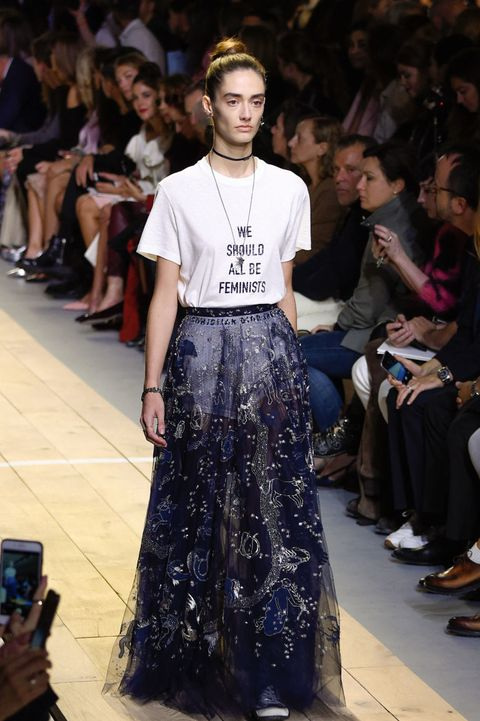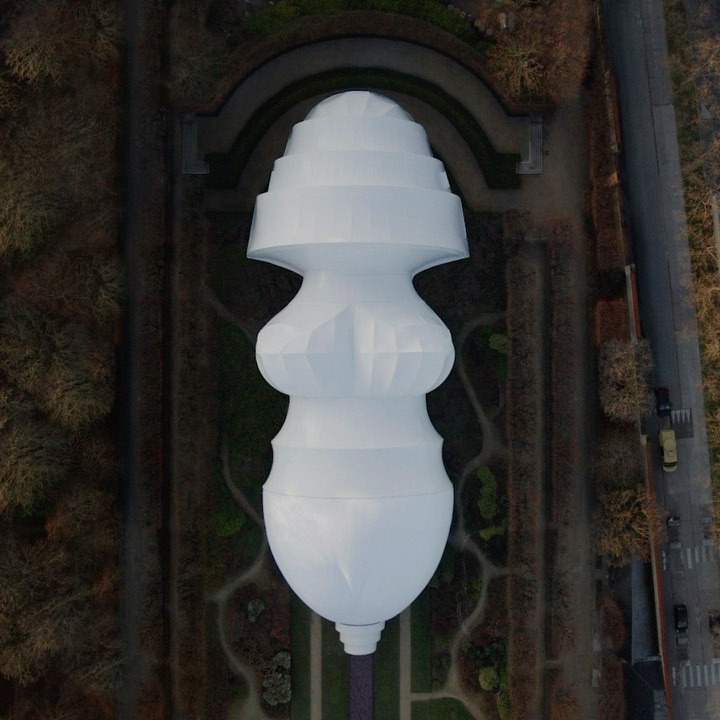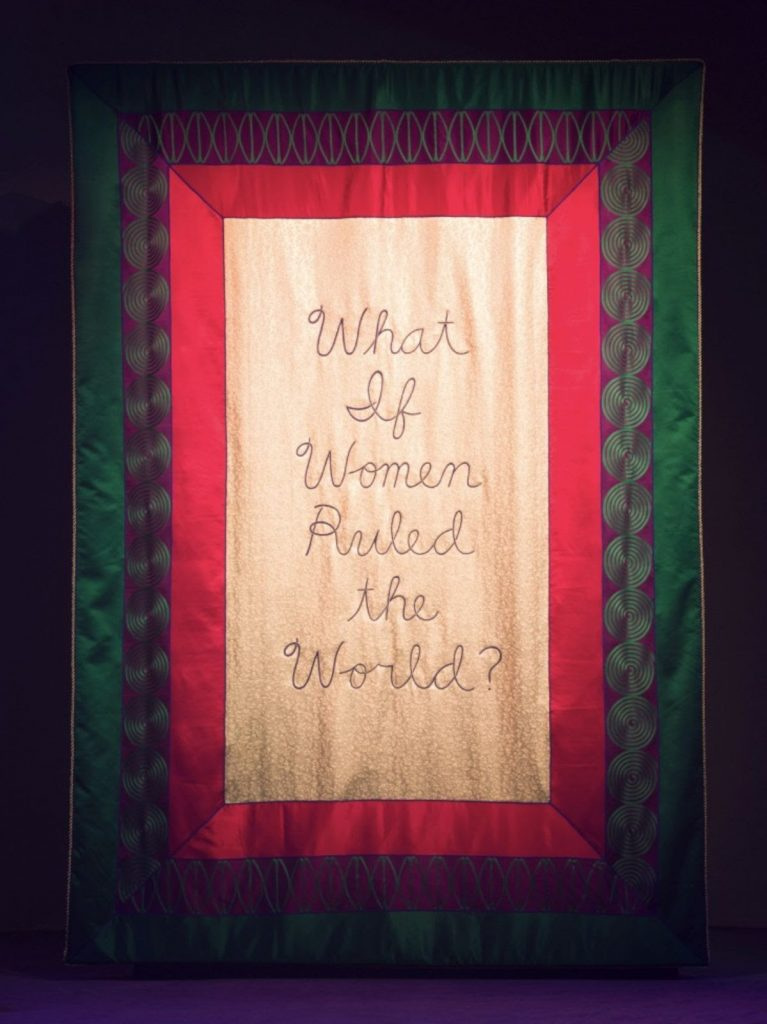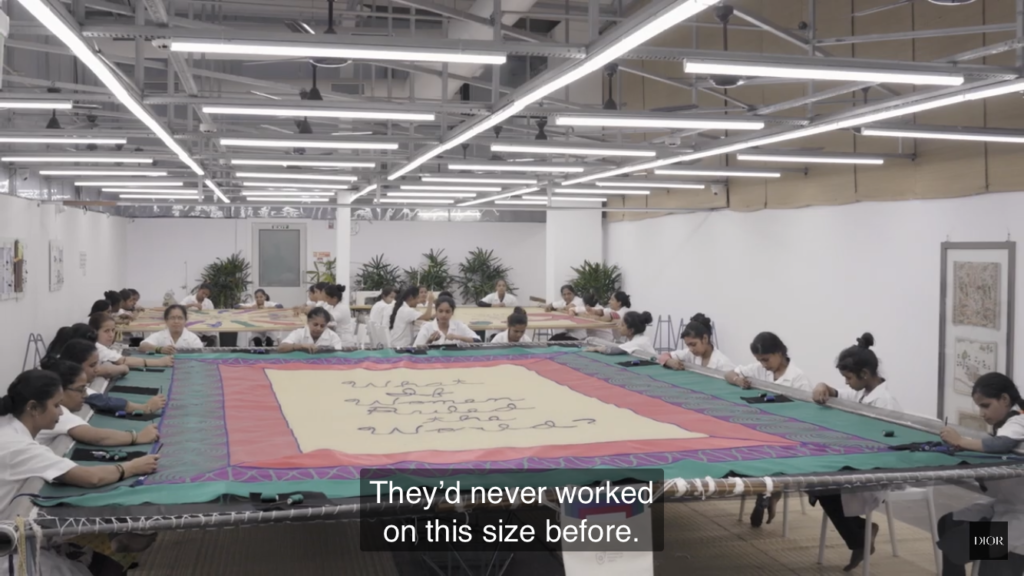
While the Art en Grève (Art on Strike) banners impose themselves increasingly in the visual field of the French art world 👏🏽, another type of banner appeared during the Paris Fashion Week at the Dior haute couture show at the Rodin Museum 🥂 on Monday, January 20, 2020.
The artist Judy Chicago collaborated with Dior and its artistic director Maria Grazia Chiuri for the presentation of the Spring/Summer 2020 collection.https://www.youtube.com/embed/e7bMScAK-Ps?controls=0
A white dome embodying an immaculate and smooth uterus lay at the heart of the presentation: a puritan fiction nicknamed the Dior Womb that perpetuates the idea that the female gender depends on reproductive organs while Dior works with transgender models, proving the lack of a proper consideration of gender issues. In this dome, the artist unveiled a substantial body of twenty-one new textile works addressing questions such as: “Would there be private property?”, “Would God be Female?”, “Would there be violence?”, “Would buildings resemble wombs?” all responding to the mother banner, which read: “What if Women Ruled the World?” 🚺


Dior’s use of an emancipatory feminist rhetoric is not new. The fashion house used Nigerian writer Chimamanda Ngozi Adichie’s ✊🏽famous slogan ‘We should all be feminists” to sell $600 t-shirts 💸 in its Spring/Summer 2017 season. Beyoncé quoted this same author several times. Nevertheless, this formulaic feminism has become an argument of choice to perpetuate and legitimize the concepts of success and wealth, which go hand in hand with oppression and precariousness.

Dior took it up a notch with its Autumn/Winter 2018 parade, which used the slogan “Women’s Rights are Human Rights”–a tribute to the spirit of the 1960’s–and claimed Claude Cahun as inspiration. Maria Grazia Chiuri said ofCahun’s photos: “I think in some ways this was the birth of the modern women” (Vogue, 2018). This sentence may appear innocent at first, but a certain violence leaps out when one understands that this celebration of Claude Cahun is encompassed in a conservative history of feminism, one which considers two genders as the only modes of existence. This history undermines Cahun’s practice as a simplistic drag king performance, thus expelling them from a proto-queer genealogy, and binds them to the reproductive female gender by mentioning “birth”.

To return to Judy’s banners, these are multiply paradoxical: the potential worlds imagined from a feminist perspective shouldn’t be rooted in the reproduction of power structures that we know too well, but on their complete reinvention (no rulers at all!!!). The banners questioning the existence of private property are also incongruous at the very heart of a Dior fashion show: listed on the Paris Stock Exchange, Christian Dior Couture was incorporated into LVMH in 2017. The latter belongs to Bernard Arnault, who is considered one of the world’s five richest men–no women are on that list 💰. Note also that the Dior Womb, when seen from the sky, reproduces the very phallic architecture decried by Judy Chicago herself (horizontally, of course!).

The production of the banners is also responsible of appalling inequalities!

The banners were embroidered in a craft school for women in India “supported” (?) by Dior. The Chanakya School of Crafts was founded more than a year ago to provide specialized labour for the Indian label Jade by Monica and Karishma (Monica Shah and Karishma Swali are the founders). The school has the status of an NGO. Its stated mission is the emancipation of precarious women and the preservation of endangered craft knowledge. It can therefore receive donations from private foundations and individuals, for which donors could potentially receive tax deduction…

Would it not have been possible for the partnership to have been founded on the basis of a donation to the school, which would have been beneficial to both parties? Would the production of the banners then be considered as an act of “charity” thus excusing the lack of direct and appropriate wages for working women?
https://www.youtube.com/embed/G2jVs8pEqxk
The video posted on Dior’s YouTube page shows a modestly sized studio. However, Outlook India specifies that the project required 150 “students” who were only paid an “honorarium”, the amount of which is not disclosed, and that each banner required between 500 and 2800 hours of work.
The pride of such an accomplishment and the school’s (among others’) desire for exposure should not obscure the operating system here: that of an underpaid or even unpaid female workforce in a country where gender and income inequalities are very high.
Mumbai Mirror quotes that workers were paid 2500 rupees/month in this program, which is the equivalent of about $35/month. The World Bank’s International Poverty Line was roughly set at $2 per day per person in December 2019: do the math! It doesn’t seem that the collaboration with Judy Chicago has inflated this figure, unlike the artist’s bank account. She once complained about her financial situation in these terms: “It’s no fun to be old and poor.” Of course, as a female artist in the United States, her situation may not be the most comfortable. But does Madame Chicago’slack of a solid and fair retirement system justify the exploitation of other women???
Later in Dior’s video, the women embroidering for Judy and Dior were asked, “What if women ruled the world?”. Their uneasiness is palpable: their own visibility accounts for Dior’s ethical practices, and giving them a voice allows Dior’s feminist message to appear universal. These questions are supposed to resonate with all women, regardless of their living conditions or individual circumstances. And yes, “We should all be feminists”, but, for Dior, preferably in the same way!
What if they had replaced their questions by the following: “What if exploitation systems were abolished?”, “Would racial inequality still exist?”, “Would white privilege be a thing?”… –obviously, these will never be asked by Dior, as it would mean the annihilation of their own privilege as feminists and whites. It’s probably not Dior’s place to ask them anyway; but it could have been Judy Chicago’s choice, given the place of honor she occupies in a certain genealogy of Western feminist art. Her questions, far from unlocking any such potential, only feed Dior’s neoliberalism while neutralizing the queer, intersectional and radical horizons of feminism.

The flaws are obvious behind the fashion house’s well-oiled communication strategy. It’s not enough to dig into Linda Nochlin’s writing to be a feminist, or to hide behind (shameful) philanthropy to excuse the near-gratuitous exploitation of female workers who are conveniently defined as “in training”.
Judy Chicago can congratulate herself on her gesture, which will only multiply invitations from major brands to participate in their ever more feminist and intersectional projects. Soon, you will be able to buy limited editions of plates inspired by the Dior Womb and designed by Judy herself!
